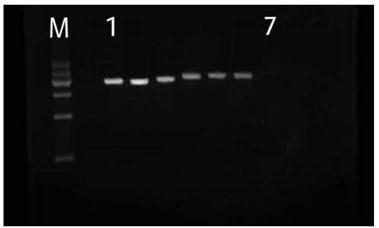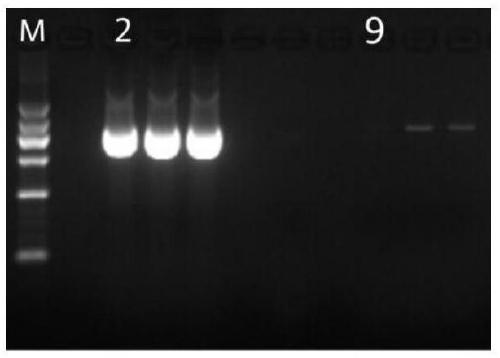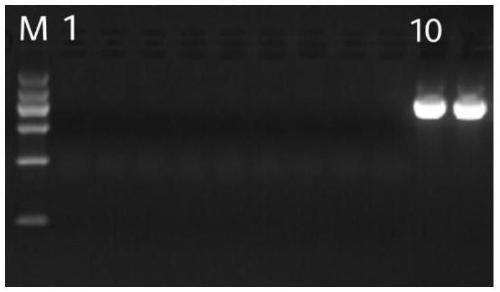PCR detection primers and detection method of prawn infectious hypodermal and hematopoietic necrosis virus
A technology of hematopoietic tissue and necrotic virus, applied in the field of molecular biology technology detection, can solve the problems of insufficient accuracy and stability, prone to missed detection, mutant strains, etc., and achieve high accuracy, high accuracy, and high sensitivity Effect
- Summary
- Abstract
- Description
- Claims
- Application Information
AI Technical Summary
Problems solved by technology
Method used
Image
Examples
Embodiment 1
[0024] Embodiment 1 Sensitivity detection
[0025] The primers for PCR detection of shrimp infectious subcutaneous and hematopoietic necrosis virus consist of upstream primers and downstream primers, and their nucleotide sequences are:
[0026] Upstream primer: 5'-AATTTCTCCAAGCCTTCTCACC-3'
[0027] Downstream primer: 5'-TCTGGCAGCAAAGGTAACTCC-3'.
[0028] Direct PCR detection:
[0029] (1) Dilute the infectious hypodermic and hematopoietic necrosis virus (IHHNV) template to 8 different concentration gradients, followed by 10 -4 、10 -5 、10 -6 、10 -7 、10 -8 、10 -9 、10 -10 、10 -11 copy / μl.
[0030] (2) Using the above primers to carry out PCR amplification reaction to obtain 8 PCR amplification products;
[0031] The reaction system of the PCR amplification reaction is 20 μL, including 10 μL of 2×Taq PCR Master Mix, 0.5 μL of upstream primer and downstream primer, ddH 2 O 8.5 μL, DNA template 0.5 μL.
[0032] The program of the PCR amplification reaction is: 3 min at ...
Embodiment 2
[0037] Embodiment 2 specific detection
[0038] In order to verify the specificity of the PCR reaction of the present invention, a negative control experiment using double distilled water as a template is carried out. The reaction system is the same as in Example 1, except that the template uses ddH 2 O instead, after the completion of the PCR reaction, a second PCR reaction was carried out using the PCR reaction product as a template to eliminate factors such as artificial contamination in the laboratory. The results of electrophoresis of the product of the secondary reaction are shown in image 3 , wherein M is DNAMarkerII, swimming lanes 1-9 are negative controls, and swimming lanes 10 and 11 are positive controls.
Embodiment 3
[0040] During the period from April 23 to April 29, 2015, 144 female Macrobrachium rosenbergii female broodstock were subjected to secondary PCR detection three times respectively. The detection method:
[0041] (1) extract the genomic DNA of the sample to be tested;
[0042] (2) using the primers of Example 1 to carry out PCR amplification reaction on the genomic DNA of the sample to be tested, to obtain PCR amplification products;
[0043] The reaction system of the PCR amplification reaction is 20 μL, including 10 μL of 2×Taq PCR Master Mix, 0.5 μL of upstream primer and downstream primer, ddH 2 O 8.5 μL, DNA template 0.5 μL.
[0044] The program of the PCR amplification reaction is: 3 min at 94°C; 1 min at 94°C, 1 min at 68°C, 1 min at 72°C, 35 cycles; 10 min at 72°C.
[0045] (3) carry out agarose gel electrophoresis (concentration of agarose is 1.5%, voltage is 70V) with the PCR amplified product of step (2), judge whether to contain prawn infectious subcutaneous and h...
PUM
 Login to View More
Login to View More Abstract
Description
Claims
Application Information
 Login to View More
Login to View More - R&D
- Intellectual Property
- Life Sciences
- Materials
- Tech Scout
- Unparalleled Data Quality
- Higher Quality Content
- 60% Fewer Hallucinations
Browse by: Latest US Patents, China's latest patents, Technical Efficacy Thesaurus, Application Domain, Technology Topic, Popular Technical Reports.
© 2025 PatSnap. All rights reserved.Legal|Privacy policy|Modern Slavery Act Transparency Statement|Sitemap|About US| Contact US: help@patsnap.com



